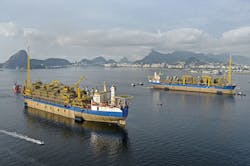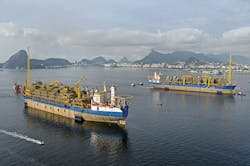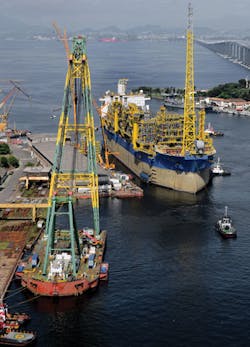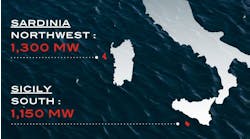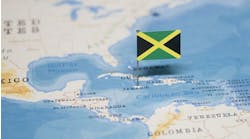BRASA shipyard completes four-year FPSO construction, integration campaign
Second 'lookalike' floater sails to presalt Lula field
Jeremy Beckman
Editor, Europe
In May, the FPSOCidade de Saquarema departed the BRASA shipyard, close to downtown Rio de Janeiro, for service on the Lula field in the BM-S-11 block in the presalt Santos basin offshore Brazil. This was the third of three successive FPSOs to undergo topsides integration at the yard within the past four years, and the second destined for Lula following Cidade de Maricá, which achieved first oil in February.
The first vessel,Cidade de Ilhabela, started production at the presalt Sapinhoá field in November 2014. It operates in 2,140 m (7,021 ft) of water, the deepest of SBM Offshore’s global floater fleet, and has the largest throughput capacity of 150,000 b/d of oil. The hulls of the two subsequent FPSOs, both based on the blueprint for the Ilhabela, were former VLCCs converted at the CGX yard in China. They provide a similar oil-handling capacity to the Ilhabelaand an associated gas-handling capability of 6 MMcm/d. Both are owned and operated by a joint venture comprising affiliates of SBM Offshore, Mitsubishi, Nippon Yusen Kabushiki Kaisha, and Queiroz Galvão Óleo e Gás, and chartered for 20 years on behalf of the BM-S-11 partners Petrobras, BG, and Petrogal Brasil.
Offshore spoke to SBM Offshore’s Managing Director Brazil, Oliver Kassam, and FPSO Director of Projects John Perkins, about how the company and its partner developed the yard from scratch to undertake complex and large-scale construction and integration of topsides modules.
Offshore: When did SBM decide to set up a yard in Brazil, and how had the company worked previously with FPSO topsides fabricators in-country?
Kassam: Prior to BRASA opening in 2012, SBM Offshore had been assembling modules with Brazilian contractors such as Brasfels, EBSE, and Enaval since its early Local Content-intensive P-57 conversion project in 2009. It also undertook the module integration at Brasfels. This modus operandi was replicated for the FPSO Cidade de Paraty- our first presalt unit.
When SBM was bidding for FPSOCidade de Ilhabela, the market was overheated and Brasfels was committed to other competing projects. In order to guarantee project delivery, on time and on budget, SBM took the strategic decision to invest in BRASA with its own module assembly yard, 2,000-ton sheer-leg crane, and integration quay. The investment was also an opportunity for sustainable development of the company’s activities in-country for the long term. Under the joint venture, Synergy GROUP runs the BRASA yard and BSL the barge crane. SBM is responsible for managing the projects, whereas Synergy GROUP makes the infrastructure available.
Offshore: What were the reasons for choosing the location in Niteroi? Is there a history of vessel building in the area, and did Brazil’s government provide a subsidy?
Kassam: Brazil was a major player in the global naval industry in the 1970s, but the industry collapsed in the late ’80s. The only surviving area with relevant activity was the Guanabara Bay area - comprising basically Rio and Niteroi. The strategic decision for choosing this area for setting up our yard came from the readily available skilled local manpower, including a strong welders’ base, and intrinsic naval know-how in the area.
Also key was the space available to put in place our plan for a 65,000-m [213,254-ft] yard with the capacity to assemble topsides modules and install them on the FPSOs using the yard’s floating crane Pelicano-1. With the help of local partners, the yard can accommodate more than two projects at a time. There has been no government subsidy; all investments were private and made by the JV partners.
Offshore: Can you outline the advantages of the chosen location?
Kassam: We believe that BRASA’s unique location, in the heart of the capital of the Brazilian oil and gas industry, Rio de Janeiro, gives SBM Offshore a competitive edge for local contracts and increases the company’s flexibility for project execution and delivery. BRASA is a strong example of commitment to sustainability with the ethical and ecological imprint on every step of the yard’s development going beyond the legal requirements imposed by Brazilian law.
The location is on the island of Ilha do Conceição within the environmentally sensitive Guanabara Bay. SBM Offshore feels strongly about conserving this heritage, and recently launched with BRASA an initiative focused on the environmental education of our collaborators and partners within our area of influence.
Offshore: Did establishment of the yard lead directly to the award of the three FPSO topsides jobs that the yard has undertaken to date?
Kassam: The establishment of BRASA was not a direct reason for the award of any project, but was rather an enabling tool that allowed SBM Offshore to have control of its own construction resources and capacity, while guaranteeing project delivery on schedule and on budget as well as contributing towards meeting our local content commitments. Using another yard, we are not always the priority, but at BRASA we control our own destiny.
Offshore: What facilities does the yard have for offshore module construction and integration, and how do these compare with other specialist sites in Brazil?
Kassam: The assembly yard provides sufficient space for the simultaneous assembly of up to 14 large-sized modules. It also includes an integration quayside on the other side of the channel (Cais 2 of Mauá). The heavy-lift barge crane can handle up to 2,000-ton modules, allowing for large lifting capacity and movability. BSL Serviços, the company that operates the crane, is owned by the JV partners, which provides lee-way and flexibility on the lifting windows and lifting priorities.
Offshore: Can you explain a recent statement that BRASA provides “the freedom to engineer how best to build modules”?
Kassam: Contractors’ design modules and their dimensions/loads depend, amongst other criteria, on crane capacity, footprint and integration quay availability. Smaller modules/skids can be assembled in smaller yards, but require more integration times, whereas larger modules will invariably require large loading capacity. BRASA and BLS give full flexibility to SBM Offshore engineers on defining what are the best dimensions and loads for the designed modules.
Offshore: How did the JV/Petrobras decide how many and which modules the yard could build for the three FPSOs, and how many to allocate elsewhere?
Perkins: The FPSO bids awarded were from Brazil’s older ANP Rounds, which provided operators with global local content (LC) requirements, and were not scrutinized per item. This allowed SBM Offshore to strategize which scopes were executed abroad, and which were executed in-country, as long as final LC indexes were within contractual requirements.
The company has executed five high-level LC projects, and all were delivered within the contractual requirements. It has built modules in Brazil through its sub-contractors and partners BRASA, EBSE and ENAVAL, and will generally allocate scope amongst these, and potentially further suppliers, depending on the demand and project execution strategy. There are no ‘fixed’ arrangements for working with the same subcontractors in Brazil - this is decided on a project-by-project basis - but high performers are naturally prioritized.
Offshore: For Cidade de Ilhabela, the yard built and integrated 10 topsides modules with a total weight of 11,200 metric tons [12.346 tons] - out of the total weight of 23,000 metric tons [25,353 tons] for all the modules. What are the comparable figures for Cidade de Maricá and Cidade de Saquarema, and which modules/how much tonnage was BRASA responsible for?
Kassam: BRASA can accommodate the simultaneous assembly of up to 14 modules and SBM Offshore leveraged this full capacity for the twin vessels Maricáand Saquarema, which were executed in parallel.
Offshore: How did the parallel conversions of these two vessels benefit from the earlier design, conversion and operating experience of the Cidade de Ilhabela and Cidade de Paraty, SBM’s first presalt floater?
Perkins:Cidade de Maricá and Saquarema have a very similar design to Cidade de Ilhabela. This allowed the project to have a very fast start with respect to both the initial engineering works and the placement of purchase orders for long-lead equipment for the topside process facilities. For critical items such as the power generator and gas compression the commitments to suppliers were made days after the main contract award. This provided clear schedule advantages. The module installation sequence was determined by evaluating the quayside integration schedule and ultimately commissioning priorities. The topside design for both vessels is also very similar to the four-level arrangement on the Cidade de Ilhabela.
Offshore: SBM has introduced work practices at BRASA based on its experience of FPSO programs at yards in the Far East. Can you provide details?
Kassam: The overall EPC project schedules are managed on a global level, with the detailed requirements of each component being defined in an integrated schedule. Each construction yard, in turn, builds its own schedule, in a manner that supports the overall schedule, using the planning expertise and tools it has developed. BRASA uses professional planning, work allocation and tracking tools to manage its work and the yard people skill sets excel in both experience and competency, which were further developed as the three Generation 3 FPSO projects were performed. [Generation 3 is SBM Offshore’s name for its FPSO design for presalt fields.)
Offshore: Did Petrobras alter the design specifications during the construction phase for any of these vessels?
Perkins: This item is covered by our Contractual Confidentiality terms and cannot be commented upon. However, we can say that SBM Offshore established its group technical standards (GTS) in 2003, largely based on industry standards, and has refined these over the past 12 years by integrating key elements of the company’s accumulated project and fleet operational experience. The company has now executed over 20 projects using GTS as the basis, including Cidade de Maricá/Saquarema. The GTS are used in the context of the client’s functional specifications and supplementary requirements as appropriate.
Offshore: Both the latest vessels are described as “carbon copies” - what were the construction challenges compared with Cidade de Ilhabela, and what are the differing production issues they are designed to deal with at the Lula field?
Perkins: These two highly complex units are almost identical, using the same class/manufactured hulls. The only differences are relatively minor in the riser balcony area, required to suit our client’s needs. This allowed us to develop a project execution plan building on this. For example, engineering was generally only needed once, then copy pasted and construction contracts were placed on a two-by-two basis.
From a topside perspectiveCidade de Ilhabela is very similar to the topside design for Cidade de Maricá and Cidade de Saquarema. The biggest single advantage from a schedule perspective was that major critical-path equipment was ordered very quickly facilitating an expedited topside equipment delivery and project execution. Although this put additional strain on the vessel conversion works that were not “carbon copies,” it was necessary to ensure they kept up with the topside pace. The Cidade de Ilhabela converted hull was single-hulled, while Cidade de Maricá and Cidade de Saquarema hulls were double-hulled. Technical production challenges for the presalt fields are numerous, and SBM’s track record and experience in this area allowed us to find the ideal solutions.
Offshore: Has the process of module integration improved progressively for each vessel?
Perkins: The biggest issue we face is the massive volume of these projects, requiring thousands upon thousands of tons of equipment and materials to be procured and then delivered to and controlled by the multiple yards we use throughout the world. The integration works themselves are all about detailed planning and using the right resources to allow the units to be commissioned to the maximum extent possible prior to installation at the offshore location.
However, our preparation works and skill sets in this area resulted in record-breaking performance, which improved from one project to the next.Cidade de Saquarema took just over four months (from first lift to quayside departure), while the experience gained on repeatability of the proven formula on twin vessel Cidade de Maricá is now paying dividends with a gain in schedule. The vessel left the quay in a very advanced state of commissioning and with very little carry over work, demonstrating the value that the SBM and BRASA teams bring.
Offshore: How has SBM’s team in Brazil interfaced with the company’s design/engineering/project management branches in Europe or elsewhere?
Kassam: In order to successfully execute such large and globally based projects using resources from multiple regional centers, a single project team was set up led by a global project management team. Clear communication, scope splits and project objectives were established across the project, with the scope allocation based on the skill sets and strengths of each individual resource center. The Rio office and BRASA yard both significantly contributed to the project particularly in the areas of construction, Brazilian supply chain activities, local regulations and field engineering support.
Offshore: Does the yard have any more work in prospect now that the two latest FPSOs have departed?
Perkins: After the sailaway of Cidade de Saquarema in May, BRASA does not have any current outstanding backlog, however it is in active discussions with operators and potential clients to acquire new projects and to sustain high levels of Brazilian content.
